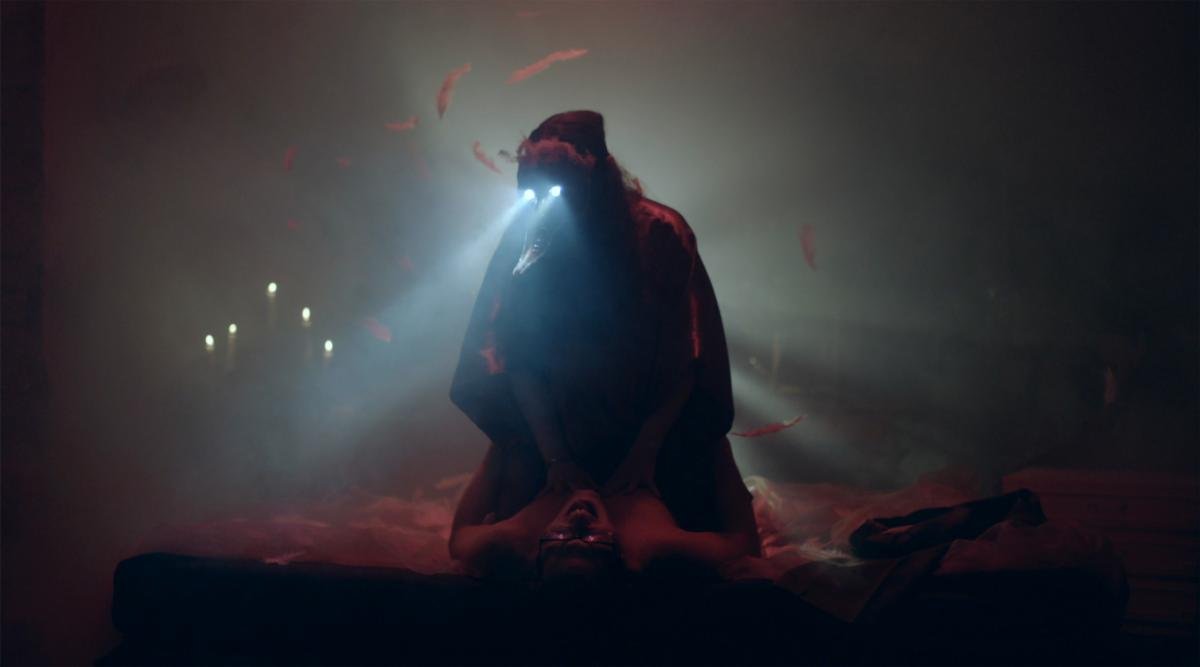Look, Kevin Kopacka’s Dawn Breaks Behind the Eyes is probably best seen without any foreknowledge about the film. That being said, I will do my damnedest to avoid any spoilers. The Austrian-Sri Lankan filmmaker evokes the aesthetics of arty and moody ‘70s Euro-horror in unexpected ways. This is no mere pastiche, though, as the film flips what have become conventional ironies back on themselves, keeping experienced film fans on their toes.
Margot (Luisa Taraz) and Dieter (Frederik von Luttichau), a toxic upper-class German couple, have inherited a castle in the countryside. Of course, the place is creepy as hell, and strange happenings start almost immediately upon the pair’s initial exploration of the structure. That the spookiness is utilized so early in the proceedings is a subtle first clue that Kopacka and cowriter Lili Villanyi are using the language of cinematic homage as camouflage. This becomes apparent with a major reveal at the end of the first act, which is where the piece becomes truly interesting.
The script has a tight structure even as it embraces ambiguity toward the finale. A few characters have dual roles of sorts, and this element is woven into the narrative with an admirable effortlessness. I don’t speak German, so it’s difficult to say, for example, if the dialog is naturalistic, but I was taken with the characters, which indicates a certain immersion, I think. The multiple surprises are effectively disguised and the basic narrative underneath it all works just fine.
Performances are solid and polished. Taraz and Luttichau seamlessly transition between the plot’s layers. Anna Platen and Jeff Wilbusch emerge as the true leads with the onset of the second act. They are absolutely believable as mirrored (or perhaps more accurately through the looking glass) versions of Margot and Dieter.
The production design is integral to the film’s success. Costumes are nicely done, especially considering some have to be vaguely timeless and others need to be era-specific. The castle set/location gives the story a sense of place while not overwhelming the visuals. The one moment of practical gore is executed perfectly and you can almost feel Kopacka’s glee at unleashing such a squirm-inducing explicit moment.
DP Lukas Dolgner both infuses the appropriate moments with the aforementioned Euro-horror atmosphere and drops in some legitimately stylish imagery of a more modern slant. Still, storytelling and character beats remain in the foreground, which was probably wise considering the narrative trickery. The photography works hand in hand with Kopacka’s editing to craft some memorable visuals. I particularly like the dreamy sequence toward the finale where Platen’s character makes a heartbreaking discovery. Plus, at just a scant 74 minutes, the movie blows by while still accomplishing everything it needs to do.
The score seems to have been assembled from several contributors. It’s definitely enjoyable, even if it isn’t necessarily cohesive. I would say that considering what happens in the movie, this makes some sense, though.
Kevin Kopacka’s Dawn Breaks Behind the Eyes pulls the rug out from underneath you a few times and then closes with some ambiguity. I have a feeling that some viewers may embrace the former and be frustrated by the latter. I personally applaud the filmmaker and his cohort for attempting to thoughtfully subvert the pastiche approach. It will be available on VOD platforms from Dark Sky Films starting on June 24th. Recommended for fans of The Others, The House of the Devil, and Mulholland Drive.
Michael Cavender





